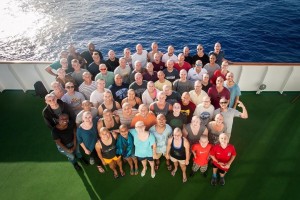Michael Willis
Semester at Sea
Spring 2016
Neptune Day is a historic maritime tradition. The transformation from pollywogs to shellbacks. This tradition takes place after you cross the equator for the first time aboard a ship. The MV World Odyssey has adapted this tradition to include the tradition of sailors shaving their heads after crossing the equator and being accepted into King Neptune’s court. The ceremony of King Neptune’s court consisted of our ship’s captain, Captain Kostas painting himself green, wearing a Santa beard, and being dressed in traditional ancient Greek regalia. A sailor first started the process of being accepted into King Neptune’s court by being covered in green slime, jumping into the pool, and swimming across the pool. Once the pollywog emerged from the pool they were immediately greeted by a fish which you had to kiss. After kissing the fish you went and paid your respects to King Neptune and kissed his ring. After completing this process you were officially welcomed into King Neptune’s court as shellbacks. To maintain the maritime tradition shellbacks were given the opportunity to go and shave their heads. I took part in this tradition and have since gotten my scalp sunburned. OOPS.

On March 9th 2016, the MV World Odyssey docked in Port Louis, Mauritius the island nation off the coast of Madagascar, which was once home of the Dodo bird. While on the Island of Mauritius I had my last field lab of the voyage. This field lab was with Intro to Environmental Science. The itinerary for the lab was to hike up La Pluece Mountain the second highest peak on the island, and then go to the Populmous Botanical Garden. This was an adventurous day that would lead to lots of slipping and sliding. It had rained the entire day before on the mountain and the trails were wet, slippery, and extremely muddy. It was a two hour hike up the mountain and an hour to get back down. Following the trail that Charles Darwin took on his trip to the island aboard the Beagle. The view from the top of La Pluece was fantastic. The view looked out on to the “bowl” of the island. This is where some volcanologists believe, was the mouth of the volcano that created the island. On the hike down, there were only one or two people who didn’t slip. The trail had turned into a creek while we were on the top. It had rained on some portions of the lower mountain after we walked through the area. Once we got to the bottom of the mountain, we then boarded our buses and headed to the Botanical Garden for a guided tour of the native and endemic plant species that were found at the garden. This particular garden is revered as the oldest garden in the southern hemisphere. We saw many different species of palms as well, some of these were 30 feet tall with leaves that were five feet across. There were many species of plants that aren’t found in the United States Botanical Gardens, because of the climate and the possibility of invasive species. This made the trip to the botanical garden a very unique one.